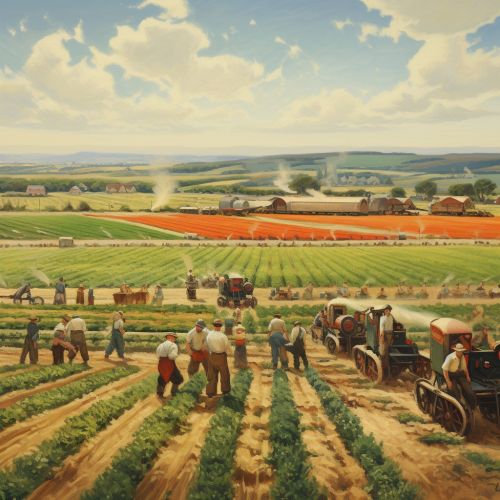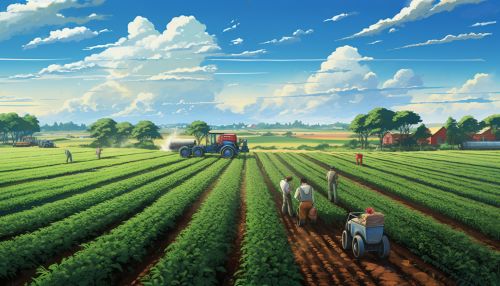Collective farms
Overview
Collective farms are agricultural production units where land and labor are pooled to increase efficiency and productivity. The concept of collective farming has its roots in socialist ideology, where it was seen as a way to eliminate class distinctions and promote equality among farmers. Collective farms have been implemented in various forms and scales across different countries and time periods, most notably in the Soviet Union, China, and other socialist countries during the 20th century.


History
The history of collective farming can be traced back to the early 20th century, when it was first proposed as a solution to the inefficiencies and inequalities of individual farming. The idea was to pool land and labor resources to create larger, more efficient farms that could produce more food and other agricultural products. This was seen as a way to improve the living conditions of farmers, who often struggled with poverty and food insecurity.
The first large-scale implementation of collective farming took place in the Soviet Union under the leadership of Joseph Stalin. The process, known as collectivization, was a key part of Stalin's plan to modernize the Soviet economy and transform it into a major world power. However, the implementation of collective farming in the Soviet Union was marked by widespread resistance from farmers, forced collectivization, and severe food shortages, leading to the infamous Soviet famine of the early 1930s.
In China, collective farming was implemented as part of the Great Leap Forward, a campaign launched by Mao Zedong in 1958 to rapidly transform the country's agrarian economy into a socialist society. However, like in the Soviet Union, the implementation of collective farming in China was marked by widespread resistance, forced collectivization, and severe food shortages, leading to the Great Chinese Famine.
Despite these challenges, collective farming has also been implemented in other countries, including North Korea, Cuba, and various African and Asian countries. In some cases, collective farming has been successful in increasing agricultural productivity and improving the living conditions of farmers.
Structure and Operation
Collective farms are typically organized as cooperatives, where farmers pool their land and labor resources to create a single, large-scale farm. The farm is managed by a committee of farmers, who make decisions about what crops to grow, when to plant and harvest, and how to distribute the farm's output.
In a collective farm, the land is owned by the state or the collective itself, and farmers are paid a wage or a share of the farm's output. This is in contrast to individual farming, where farmers own their land and keep all of the profits from their labor.
Collective farms often have access to modern farming equipment and techniques, which can greatly increase their productivity. They may also benefit from economies of scale, which can lower costs and increase efficiency.
However, collective farming also has its challenges. For example, it can be difficult to motivate farmers to work hard when they do not own the land they are working on and do not directly benefit from their labor. This is known as the free-rider problem, and it has been a major challenge in many collective farming systems.
Impact and Criticism
The impact of collective farming has been a subject of much debate. Supporters argue that it can increase agricultural productivity, improve the living conditions of farmers, and promote equality. They point to successful examples of collective farming, such as the Kibbutz system in Israel, as evidence of its potential benefits.
Critics, however, argue that collective farming can lead to inefficiencies, food shortages, and human rights abuses. They point to the forced collectivization and famines in the Soviet Union and China as evidence of the potential dangers of collective farming.
In addition, some critics argue that collective farming is inherently unfair, as it requires farmers to give up their land and labor for the benefit of the collective. They argue that this violates the principle of private property rights, which is a fundamental aspect of capitalism and liberal democracy.
Despite these criticisms, collective farming continues to be practiced in various forms around the world. In some cases, it has been adapted to fit local conditions and needs, resulting in a variety of different models and approaches.
